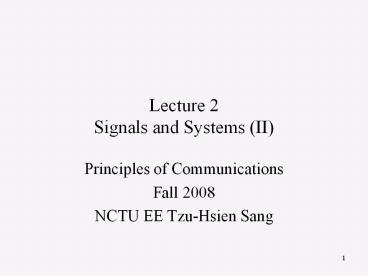Lecture 2 Signals and Systems (II) - PowerPoint PPT Presentation
1 / 23
Title: Lecture 2 Signals and Systems (II)
1
Lecture 2Signals and Systems (II)
- Principles of Communications
- Fall 2008
- NCTU EE Tzu-Hsien Sang
1
1
2
Outlines
- Signal Models Classifications
- Signal Space Orthogonal Basis
- Fourier Series Transform
- Power Spectral Density Correlation
- Signals Linear Systems
- Sampling Theory
- DFT FFT
2
3
More on LTI Systems
- A system is BIBO if output is bounded, given any
bounded input. - A system is causal if current output does not
depend on future input or current input does not
contribute to the output in the past.
4
- Paley-Wiener Condition
- Remarks (1) H(f) cannot grow too fast.
- (2) H(f) cannot be exactly zero over a finite
band of frequency. - 2nd ver.
5
Eigenfunctions of LTI Systems
- Another way of taking complicated things part.
- Instead of trying to find a set of orthogonal
basis functions, lets look for signals that will
not be changed fundamentally when passing them
through an LTI system. - Why?
- Consider the key words analysis/synthesis.
- Note Eigen-analysis is not necessarily
consistent with orthogonal basis analysis.
6
- If , where a is a
constant, then a is the eigenvalue for the
eigenfunction g(t). - Let
7
- (Cross)correlation functions related by LTI
systems - Note In proving them, we use
Filters!!!
8
- Since almost any input x(t) can be represented by
a linear combination of orthogonal sinusoidal
basis functions , we only need to input
to the system to characterize the
systems properties, and the eigenvalue - carries all the system information responding to
. (Frequency response!!!) - In communications, signal distortion is of
primary concern in high-quality transmission of
data. Hence, the transmission channel is the key
investigation target.
9
- Three major types of distortion caused by a
transmission channel - 1. Amplitude distortion linear system but the
amplitude response is not constant. - 2. Phase (delay) distortion linear system but
the phase shift is not a linear function of
frequency. (Q What good is linear phase?) - 3. Nonlinear distortion nonlinear system
10
- Example Group Delay
11
(No Transcript)
12
- Example Ideal general filters
13
- Realizable filters approximating ideal filters
14
The Uncertainty Principle
- It can be argued that a narrow time signal has a
wide (frequency) bandwidth, and vice versa
15
Sampling Theory
- Youve probably heard of signal processing. But
how to process a signal? - For instance, the rectifier maxx(t), 0.
- But, how to do Fourier transform of an arbitrary
signal x(t)? - Computers seem a good idea. But computers can
only work on numbers. - We need to transform the signal first into
numbers. - Q Tell discrete signals from digital signals.
16
Hopefully the math becomes easier in ideal case.
The concept actually is harder.
- Ideal sampling signal impulse train (an analog
signal) , T the sampling
period - Analog (continuous-time) signal
- Sampled (continuous-time) signal
17
- Aliasing If The replicas of X(f)
overlap in frequency domain. That is, the higher
frequency components of overlap with the lower
frequency components of X(f-fs).
18
- Nyquist Sampling Theorem
- Let x(t) be a bandlimited signal with X(f) 0
for . (i.e., no components at
frequencies greater than W.) Then x(t) is
uniquely determined by its samples
if .
19
- In other words, oversampling preserves all the
information that x(t) contains. It is possible to
reconstruct x(t) purely by its samples. - Ideal reconstruction filter (interpretation in
frequency domain - In time domain
20
- Two types of reconstruction errors
21
DFT FFT
- You can view DFT as a totally new definition for
a totally different set of signals. Or you can
try to connect it to the Fourier Transform.
22
(No Transcript)
23
- Fast Fourier Transform (FFT) is not a new
transform, it is simply a fast way to compute
DFT. So, dont use FFT to denote the object that
you want to compute only use it to denote the
tool that you use to compute it. (Gauss knew the
method already!) - Application example Fast convolution via FFT































